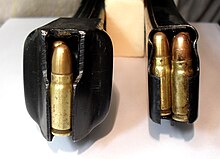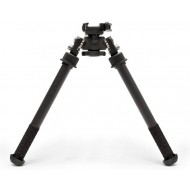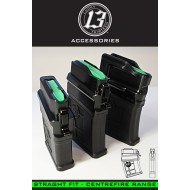
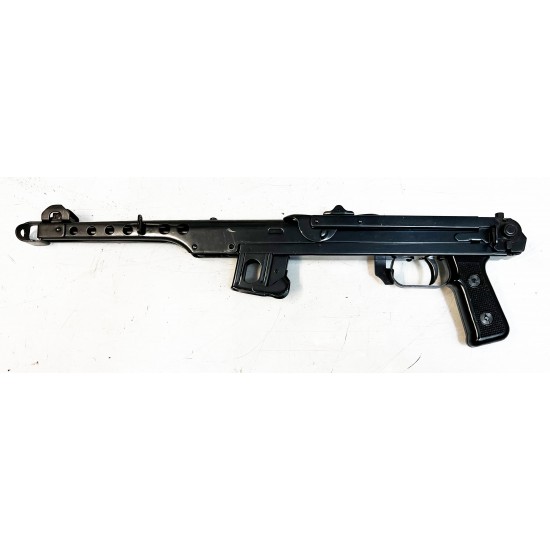
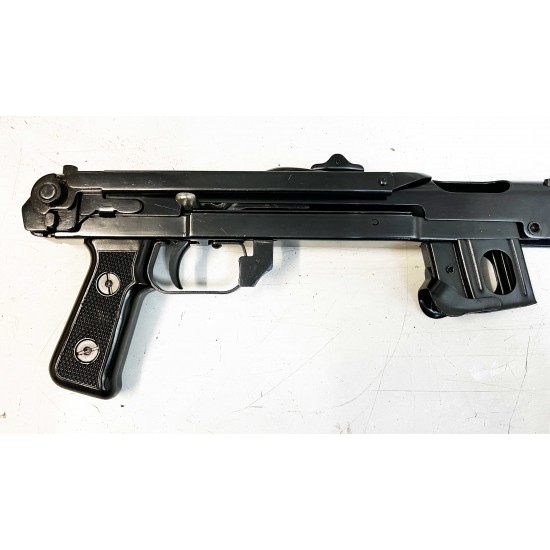





Sudayev PPPS-43 7.62 x 25 FULL AUTO SMG Polish 1951 with one magazines 257-A30RND. This is a C Cat fIrearm and required a collectors license. This is a mint condition 1951 unfired Cold War Sudayev PPS-43.
The PPS (Russian: ППС – "Пистолет-пулемёт Судаева" or "Pistolet-pulemyot Sudayeva", in English: "Sudayev's submachine-gun") is a family of Soviet submachine guns chambered in 7.62×25mm Tokarev, developed by Alexei Sudayev as a low-cost personal defense weapon for reconnaissance units, vehicle crews and support service personnel.
The PPS and its variants were used extensively by the Red Army during World War II and were later adopted by the armed forces of several countries of the former Warsaw Pact as well as its many African and Asian allies.
History
The PPS was created in response to a Red Army requirement for a compact and lightweight weapon with similar accuracy and projectile energy to the Soviet PPSh-41submachine gun widely deployed at the time, with reduced rate of fire, produced at lower material cost and requiring fewer man-hours, particularly skilled labour.
Sudayev was ordered by the State Commission for Armaments to perfect for large-scale production the sub-machine gun design of Lieutenant I.K. Bezruchko-Vysotsky from the Dzerzhinsky Artillery Academy, who had created two prototypes in 1942; the second of these was the basis of Sudayev's gun.
During design, emphasis was placed on simplifying production and eliminating most machining operations; most of the weapon's parts were sheet-steel stamped. These measures reduced the number of machined components to a bare minimum, cutting down machining time by more than half, to 2.7 hours of machining instead of 7.3 hours for the PPSh-41. There were also savings of over 50% in raw steel usage, down to 6.2 kg instead of 13.9 kg, and fewer workers were required to manufacture and assemble the parts. Thanks to the improvements in production efficiency, the Soviet planners estimated that the new gun would have allowed an increase in monthly submachine gun output from 135,000 units to 350,000 weapons.
The PPS remained in service with some Soviet forces until the mid-1950s. Among the last to relinquish it were crews of armored vehicles and the Naval Infantry.[7]Some World War II-era weapons found their way to the Chinese People's Liberation Army and were subsequently captured by UN forces in the Korean War.
esign details[edit]
Section figure
Operating mechanism[edit]
The PPS is an automatic blowback-operated weapon that fires from an open bolt.[4] The bolt is cylindrical in shape and contains a spring-loaded claw extractor, which pulls the empty case out of the chamber to be ejected. The ejector is mounted at the head of the recoil spring guide rod, which runs through a hole in the bolt. The charging handle is integral to the bolt and is located on the right side; it reciprocates during firing. Early versions of the PPS had a fixed but replaceable firing pin, held in place by the extractor spring. Pulling the trigger releases the bolt, which moves forward, stripping a round from the magazine, chambering it and striking the primer in one motion.
Features[edit]
PPSh vs PPS box magazine
The PPS has a trigger mechanism that allows only fully automatic fire and a manual safety that secured them against accidental discharges. When in the "safe" position (engaged by sliding a metal bar forward of the trigger guard), both the bolt and trigger are disabled.[4]
The weapon is fed from curved 35-round box magazines. They are not interchangeable with magazines used in the PPSh-41, nor can the gun use drum magazines. The PPS-43 magazine was significantly improved over the magazine from the PPSh-41, which contributed to greater reliability. The largest change being the transition to a "Double-Feed" design, so the double-stacked rounds are not bottle-necked into a single-stack at the feed lips.[11] Like the PPSh-41, it is chambered for the 7.62×25mm Tokarev M1930 pistolcartridge.
The submachine gun's rifled barrel (with 4 right-hand grooves) is mounted in a perforated sheet metal heat guard and is equipped with a crude muzzle brake, consisting of a strip of steel bent into a U-shape that deflects exiting muzzle gases to the sides and backwards, thus compensating for recoil.[4]
A folding stock is attached to the receiver with a spring-loaded catch button on the top. The stock folds up and over the receiver top cover and the weapon can be fired in this arrangement. The submachine gun also has a pistol grip but was not provided with a forward grip as the magazine well was intended to fulfill this role. The PPS was usually supplied with two magazine pouches, an oil bottle, bore brush and sling.
The PPS-43 was highly cost effective and easy to manufacture due to its efficient and simple, largely sheet metal design. And despite its crudeness, has been described as functional, practical, controllable, and reliable.
Sights
The PPS is fitted with a set of open-type iron sights consisting of a fixed front post protected from impact by two sheet metal plates and a flip rear sight with two pivoting notches, for firing at 100 and 200 m.
- PPS-43 (ППС обр.1943 г.) Towards the middle of 1943 the modernized PPS-43 entered production; efforts were made to improve manufacturing and safety. The ventilated heat shield was integrated with the upper receiver cover, both the barrel and shoulder stock were shortened, the stock's locking mechanism was simplified, the casing ejector was moved to the head of the recoil spring guide rod, the magazine well angle was increased in the receiver in order to enhance feeding reliability and the safety was improved to block the trigger and lock the bolt in either the open or closed positions. PPS-43s were seldom captured by the Germans, unlike the PPS-42, as the Red Army was no longer on the defensive in 1943.
 Poland Between 1952–1955, the Łucznik Arms Factory in Radom built approximately 111,000 PPS submachine guns.
Poland Between 1952–1955, the Łucznik Arms Factory in Radom built approximately 111,000 PPS submachine guns.- PPS wz. 43, the PPS-43 which was license-produced from 1948
- Stock: 1
- Model: Sudayev PPS-43 7.62 x 25 FULL AUTO SMG Polish 1951
- Weight: 3.00kg
- SKU: PPS-43


